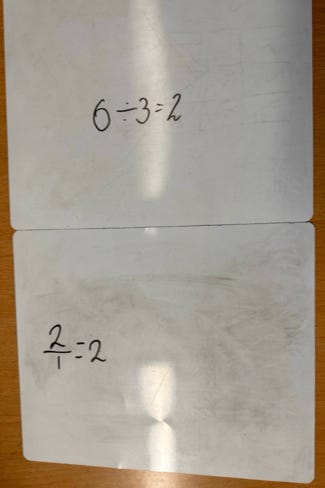#53 Ask students to put their mini-whiteboards together
This simple idea can help supercharge paired discussions
Hello, and welcome to the Tips for Teachers newsletter.
I have 7 free websites
I write 2 free weekly newsletters
I host 2 free podcasts
I share over 200 free CPD videos
If you find my work useful, please consider becoming a Patreon
💡 A tip to try in class this week 💡
Recently, I watched a maths lesson where the teacher asked this question:
The teacher asked his students to work out the answer independently on their mini-whiteboards. As I circulated, I noticed there was a range of answers in the room:
The teacher then asked his students to discuss their answers with their partners. Now, with such a variety of responses, you would expect a positive, productive paired discussion. However, the reality was the discussion was stifled. One student told their partner their answer, their partner then said what they got, and then things kind of fizzled out.
In the coaching session that followed, I suggested a tiny tweak: ask the students to put their mini-whiteboards in between them during the paired discussion. We rehearsed this and then planned how the teacher could implement it the next day.
The following day, with the same class, the teacher set them this challenge:
Again, students were given time to work independently on their mini-whiteboards. But when it came time for the paired discussion, students were asked to put their mini-whiteboards between them:
The difference was startling.
The students’ body positions changed. Instead of sitting upright, they leaned into the space between them to focus on their boards.
There was no awkward silence as there often can be at the start of paired discussions. Instead, the students launched straight into their explanation because they had the catalyst of the mini-whiteboard to kick-start the conversation.
But the most important difference was how quickly the dialogue turned from: I think this… I think this… into an actual discussion. The positioning of the mini-whiteboards became a natural frame of reference. Students could easily notice similarities and differences in their approach and answers, which they were compelled to talk about. Even when answers were the same (see the second picture), the mini-whiteboards revealed a different approach, which again gave students something to talk about.
Combine this with my favourite three questions to ask students after a paired discussion, and you have the ideal way to supercharge student collaboration.
What do you think of this idea?
What would you need to change to make this tip work for you?
When could you try it for the first time?
View more than 200 Tips for Teachers
🏃🏻♂️Before you go, have you… 🏃🏻♂️
… tried last week’s tip about introducing checks for listening using non-subject content?
… read my latest Eedi newsletter about seven ways to use diagnostic questions to check for understanding?
… listened to my latest podcast about feedback cycles, lesson observations and Exit Tickets?
… read my Tips for Teachers book?
… considered booking some CPD, coaching or maths department support?










